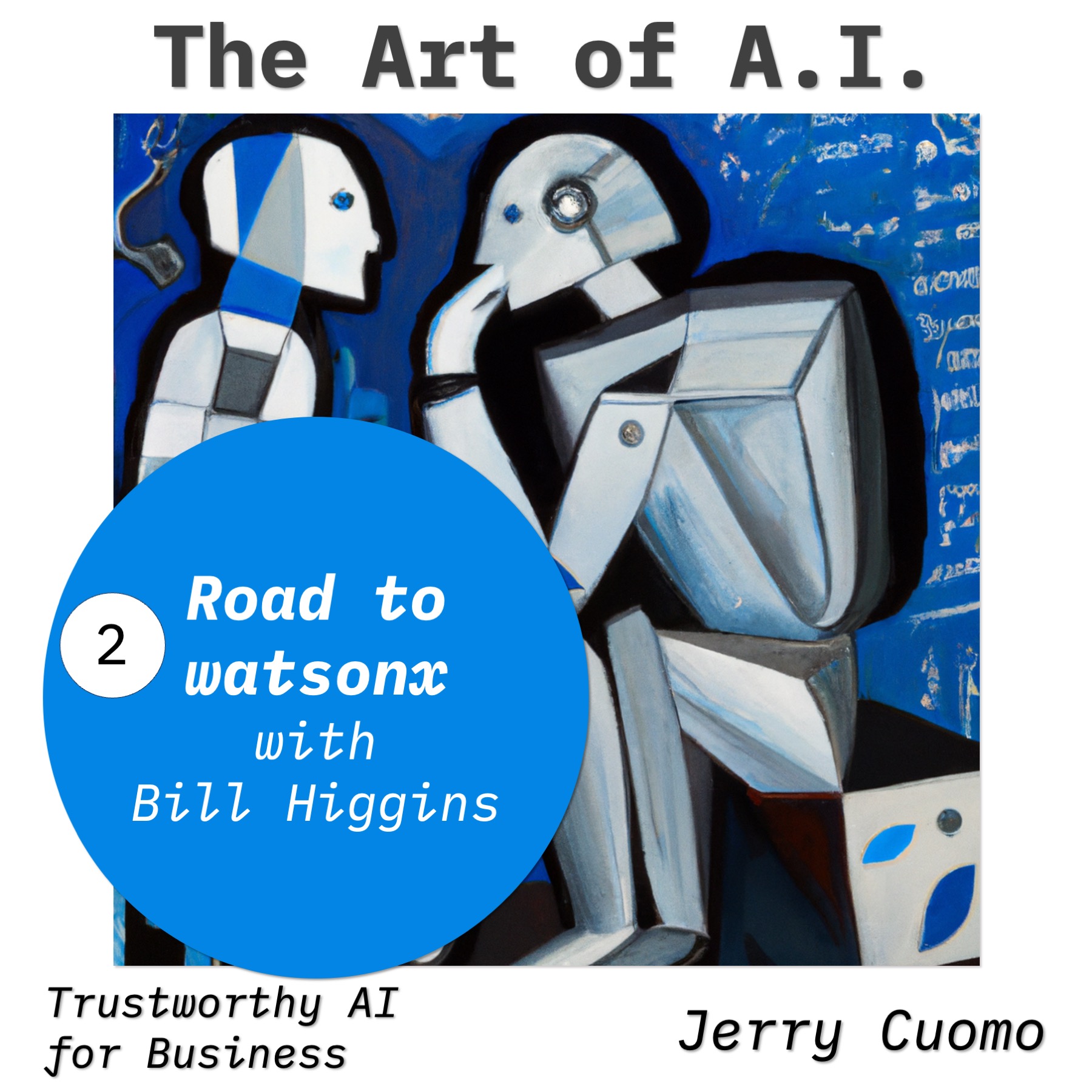Road to watsonx - Part 2
- 0.5
- 1
- 1.25
- 1.5
- 1.75
- 2
Speaker 1: You are listening to the Art of AI podcast with your host, Jerry Cuomo.
Jerry Cuomo: Thank you, DJ. All right, folks, I'm back here with Bill Higgins and we're ready to resume. Hey, Bill.
Bill Higgins: Hey, there.
Jerry Cuomo: All right, where did we leave off? Oh yeah, ChatGPT just entered the world scene and inside IBM, Bill has just been given the engineering reins to reimagine watson as the centerpiece of the AI part of IBM's hybrid cloud and AI strategy. And this episode is part two of this two part series, which is a bit AI history lesson, a bit behind the scenes look within IBM AI, and also a look at the year to come in AI. If you haven't checked out part one, it's probably a good idea to do that and then you can jump right back in after that. Okay. Bill is here. So great. Let's continue our drive on the road to watsonx and I suspect we'll be covering things like the big relaunch at Think, partnerships and alliances, which are just a few stops up ahead.
Bill Higgins: Yep.
Jerry Cuomo: Okay, Bill, you were telling us things were starting to come together. Why don't you take it from there?
Bill Higgins: Sure. So last time I mostly talked about IBM, but for this next part we also need to talk about Red Hat. As most folks probably know, Red Hat has always been a pioneer in building open source based products. And IBM acquired Red Hat in 2019 and embarked on our hybrid cloud and AI strategy. From the beginning, on the hybrid cloud side, we rebased all IBM products on Red Hat OpenShift, which is the Kubernetes space runtime that enables both portability and secure interoperability across clouds, on premises, edge, et cetera. But on the AI side, for the first few years we had product alignment but not really stack alignment because back then Red Hat really majored on cloud and minored on AI. But then in late 2022, the IBM and Red Hat senior leadership team determined that the time was right to add a first class generative AI platform layer into OpenShift as open source. So we brought together everything we've been talking about, the Red Hat AI team, the watson core team, the foundation model team in IBM Research, the watson product teams. And we decided to open source most of the watson core stuff so that it could run at that Red Hat layer since it had been proven in production for several years. But then a funny thing happened. OpenAI released ChatGPT and it upended the AI world. For IBM, and this might surprise the audience, we actually saw this as a good thing. ChatGPT is built on the same foundation model and generative AI underpinnings that we had started betting big on a few years before in IBM Research. But before ChatGPT, only the biggest of AI nerds just knew how powerful and transformational this new architecture was. So when ChatGPT came out, every human on earth with a computing device and a connection to the internet realized how powerful it was. And all of a sudden our senior leadership team starts getting deluged by calls from enterprise CEOs, CTOs, and CIOs asking how can I have something like ChatGPT for my applications, let's say for my enterprise. So now the path we've been going down already with foundation models in the COMMON. STACK and open source had orders of magnitude more market demand, and you know the rest of the story. In the opening Think keynote, our CEO, Arvind Krishna, announced watsonx as sort of the next generation of the IBM AI technology and really bringing watson back as the central brand for IBM AI.
Jerry Cuomo: Yeah. And then shortly after Arvind's talk, Darío Gil, our SVP of IBM Research, he gave what I feel as perhaps the best technical keynote that I've ever heard where he took an up close look at the newly announced watsonx. In fact, I think I was sitting right there next to you during the session, Bill. Now he brought a guest on stage and unveiled a pretty important partnership that I know you had a little something to do with. Can you pick up the story from there?
Bill Higgins: Yeah. So it was a funny thing. It occurred to me that Hugging Face could be a really excellent partner for watsonx. So for folks who don't know Hugging Face, they're effectively the world's defacto open source AI community. Like a lot of AI open source experiments start there. It's got this really vibrant community. It's almost like the GitHub of AI.
Jerry Cuomo: Agreed.
Bill Higgins: So since we were building a platform for generative AI where we're really focused on the hybrid case, not just run anywhere but be able to run mini models, IBM models, open source models, other proprietary models, custom- built models, it just made sense that Hugging Face and IBM would go together really well. So reached out to the Hugging Face guys, disclosed to them what we were going to announce at Think, and said, " We would really love for you to be a really big launch partner." In Darío's keynote that you mentioned, he talked about the platform, but then the second half of his talk was called Bet on Community. And that's where we really laid out for the first time our principles that we don't expect to live in a single model world and we actually want to advocate for a multi- model world. And we really want to bet on creators, not just consumers of AI. And then he invited Clem Delangue, the CEO of Hugging Face, out on stage to talk about these principles and announce the watsonx and Hugging Face partnership.
Jerry Cuomo: Good stuff. Good stuff. Yeah. The ecosystem play is going to be a big deal. With multi- models and stuff, it's going to be model- topia out there and no one model is going to rule them all. I believe this to be so true. And it's consistent when you think about how we've shifted to work with open source and ecosystems in the past, working with organizations like Apache and the Linux Foundation. So from a wisdom of the crowd perspective, it's cool to see that watsonx is affiliated with a set of elite partners like Hugging Face, Meta, and a bunch more. I see this as a really exciting partnership, but I have a feeling there's even more. So please keep going.
Bill Higgins: So if you look at the history of the computing industry, there's this pattern that recurs. Whenever a new platform technology emerges, the world splits into two camps, single vendor walled gardens, which sometimes become monopolies, and open ecosystems built around open standards, open source and open communities. So some examples are Windows versus Linux, Internet Explorer versus HTML5, iOS versus Android, hyperscaler proprietary APIs versus Kubernetes. At the moment, we don't really have a broad open ecosystem that we can rally around. We have pieces of it with probably the best example being something like PyTorch as a defacto standard open source machine learning framework that's under open governance. But we didn't have a broad and aligned open ecosystem in AI. Bookmark that thought for a moment. So now another consequence of the world realizing the power of next- gen AI was that the world's governments started getting much more serious and aggressive in trying to understand and reason about the current and potential societal harms that could occur and started exploring what regulation should be put in place. And of course, pretty quickly a number of players who favor the closed AI ecosystem started lobbying those regulators saying essentially AI is too dangerous to be open. Let's put in place regulations that really only allow a small number of super wealthy companies in the US West Coast to build the most powerful AI. Now of course, in IBM, we believe in open ecosystems and we've been strong supporters of open ecosystems for decades. So this stuff going on in the regulatory space really motivated us to play a leading role in promoting open ecosystems. So Darío Gil led a small working group to build an AI alliance of companies, academic institutions, and nonprofits who can work together to advance open innovation in AI and to demonstrate to both the world citizens, the governments, and companies that not only can openness lead to powerful AI technology, but it'll actually lead to improved safety and reduce current and future societal harms. So alongside our friends at Meta, we announced the AI Alliance in December.
Jerry Cuomo: I love that. Bill, can you tell our listeners a little more about the overall scope of the Alliance?
Bill Higgins: Yeah, so the scope of the AI Alliance is pretty broad. There's four big focus areas, and you can see these on the website. The first one is responsible and scalable AI. This is about how do we have standardized benchmarks, tools and methodologies to ensure and evaluate high quality and safe AI. So you can picture this as standards, papers going out, toolkits going out where we can increase both the actual safety but also the perception of safety with the public for AI. The second one is open foundation models. So another thing that we did this year that we're really proud of is in collaboration between IBM, NASA and Hugging Face, we released this geospatial model to assist people with using foundation models to better understand the effects of climate change, which will help us combat climate change.
Jerry Cuomo: Yeah, I love that.
Bill Higgins: And so we're going to be doing more of those science- focused models as well as thinking about how can we safely do large language models in a more open inclusive way, not just the building of them, but also making them accessible to researchers to find the problems with them and find the opportunities to improve them. The third one is diverse AI hardware. So right now one of the biggest bottlenecks with AI is access to GPUs. So if we can make it more of a level playing field to use multiple hardware providers for GPUs, that'll just accelerate the ability of powerful AI, but also reduce the total cost of ownership. And then finally, skills, education and research, try to help people get through to the other side. So those are the four big focus areas of the AI Alliance.
Jerry Cuomo: That's quite the movement, Bill. And I heard there were like a hundred pings the day after the announcement for groups wanting to join. That's pretty cool.
Bill Higgins: Yeah.
Jerry Cuomo: And I hear we now have quite the diverse set of members and diversity drives innovation. So high hopes here. And that's especially true because we are in the early days, some even say the wild, wild west of AI. There is some fear, uncertainty, and even doubt in the air as well. So the path to putting this amazing technology to work is to understand it in the open, focusing on transparency and trust. And to do that, that's beyond the responsibility or capability of any one company or entity.
Bill Higgins: Yep.
Jerry Cuomo: That's nice, Bill. Okay. It is now crystal ball time. I'd like to, if you can, take out that crystal ball, gaze into it and tell us what you see for the future.
Bill Higgins: Yeah, so it seems like this stuff changes day to day, week to week. So it seems pretty unwise to create longer term predictions. But one that I do feel pretty confident about, if you think about the way these technologies get adopted by big institutions, enterprises, governments, it always takes a while. And so ChatGPT came out in November 2022 and it was kind of like the worst time for big companies and governments to think about, " Oh, how can we make big investments for 2023?" Because by that point the budgets are already baked. So I think what's happening is 2023 was the year of dabbling in experiments and actually planning out the major investments. And so I really think a couple things will happen in 2024. The first one is this is where we'll really see generative AI to become part of the backbone of businesses, we'll start to see governments use it, which will both advance the capabilities of these companies and these systems, but it will also lead to problems. I'm sure there'll be a few really high profile generative AI disasters next year as some bank or some insurance company's, like, " We now use generative AI for whatever. And oops, we forgot about the hate, abuse and profanity." So I think 2024 will be both the first really broad rollouts of generative AI and also the first big accidents and then the cycle that comes from that. Like the blame cycle, the how can we double down on safety? Should we strengthen the laws? So I think it should be another interesting year. And of course the other thing is, I'm sure there'll be a few surprises that we just can't predict that will upend everything because nobody but OpenAI had ChatGPT on their bingo card about 15 months ago.
Jerry Cuomo: All right, we've reached that time. I want to thank you, Bill, for sharing your story of the road to watsonx and how IBM has fine- tuned its AI strategy. And like you said, watsonx is built from the best that IBM Research and technology has to offer. Then add Red Hat, open source and alliance partners all working to cultivate watson in a context of an ecosystem aiming at putting AI in play, but doing it with an eye to trust and safety. So thank you for being part of this podcast and our first twin, Bill.
Bill Higgins: Thanks. Great to talk to you as always.
Jerry Cuomo: Well, this episode's a wrap. I've included links in the description section of this podcast on events mentioned, like Darío Gil's keynote at Think 2023, and more. And once again, I'd like to thank Bill, and I'd also like to thank you all for joining in again. This is Jerry Cuomo, IBM Fellow and VP of Technology at IBM. I'll catch you on the next episode.
DESCRIPTION
Welcome to Part 2 of our discussion on IBM's AI evolution titled, the 'Road to watsonx'. Host Jerry Cuomo is joined again by Bill Higgins, as they pick up from where they left off in the first episode.
Bill shares insights on the creation of watsonx, revealing IBM's strategic shift towards generative AI, collaboration with Red Hat, and leveraging IBM Research technology and open-source.
Jerry and Bill also offer insights into IBM's key partnerships and alliances, notably the collaboration with Hugging Face, a pivotal player in the open-source AI community. Bill shares his personal experiences that helped shape IBM's partnership strategy and how these collaborations are shaping the future of AI.
Additionally, listeners will gain a comprehensive understanding of the AI Alliance initiative initialed by IBM and Meta, focusing on promoting open-source AI technologies while prioritizing safety and inclusivity. Bill discusses the impact of these initiatives on the AI industry and how they align with Ihis vision for the future of technology.
This two part series offers a unique blend of history, personal stories, and forward-looking perspectives in AI. Listen in for an intriguing and thought-provoking conversation that's not just about technology, but also about the people and culture driving it forward.
Key Takeaways:
- Watsonx's Central Role: Highlighting watsonx as a critical component in IBM's strategy, marking a new phase in the company's AI and hybrid cloud ventures.
- IBM-Hugging Face Collaboration: Examining the strategic partnership between IBM and Hugging Face, emphasizing its impact on enhancing IBM's AI capabilities through open-source collaboration.
- The AI Alliance Initiative: A look at IBM's leadership in the AI Alliance, focusing on the promotion of open-source AI technologies and the importance of safety and inclusivity.
- Strategic Partnerships in AI: Discussing IBM's approach to integrating various AI technologies and models, underscoring the importance of diverse partnerships for technological growth.
- IBM's Vision for AI's Future: Reflecting on IBM's commitment to driving AI innovation through collaborative efforts, shaping the future landscape of AI technology.
Additional Resources:
- Darío Gil's keynote at THINK 2023 on the IBM Research Blog. This presentation covers generative AI and the launch of Watsonx, offering a glimpse into IBM's AI strategies. Visit the blog for more details: IBM Research Blog - Darío Gil Keynote.
- Hugging Face announced their partnership with IBM on watsonx.ai, a venture blending open-source AI and enterprise solutions. Details at Hugging Face Blog.
- Meta and IBM have initiated the AI Alliance, uniting over 50 entities, including Intel and Oracle, to advocate for an open AI model, aiming to explore and advance trustworthy AI technologies. For in-depth coverage, see the full article at The Wall Street Journal."
* Coverart was created with the assistance of DALL·E 2 by OpenAI. ** Music for the podcast created by Mind The Gap Band - Cox, Cuomo, Haberkorn, Martin, Mosakowski, and Rodriguez
Today's Host

Jerry Cuomo
Today's Guests








